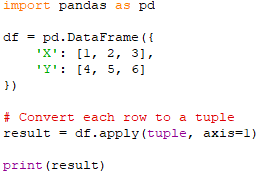|
||||||||
.apply(tuple, axis=1) - Python Automation and Machine Learning for ICs - - An Online Book: Python Automation and Machine Learning for ICs by Yougui Liao - |
||||||||
| Python Automation and Machine Learning for ICs http://www.globalsino.com/ICs/ | ||||||||
| Chapter/Index: Introduction | A | B | C | D | E | F | G | H | I | J | K | L | M | N | O | P | Q | R | S | T | U | V | W | X | Y | Z | Appendix | ||||||||
================================================================================= This command, .apply(tuple, axis=1), is used to convert each row of a DataFrame into a tuple. For instance, when we use .apply(tuple, axis=1), pandas applies the tuple function across each row (because axis=1), which effectively turns each row into a tuple of its values. It’s often used when you need a tuple representation of row data, which can be useful for creating keys in dictionaries, quick comparisons, or filtering based on row values. Here, this function, .apply() method, is used to apply a function along the input axis of the DataFrame. The function you apply can be any callable that takes a DataFrame (or Series) as its input and returns a list-like or scalar value. The function "tuple" is a built-in Python function that is being passed as the callable to .apply(). It converts its input into a tuple. When used within .apply(), it is applied to each row or column of the DataFrame, depending on the specified axis. This parameter, axis=1, tells .apply() to apply the specified function across columns for each row. This means for each row in the DataFrame, the values across the columns are taken and tuple converts these values into a tuple. =========================================== Convert each row to a tuple: consider a DataFrame with columns 'X' and 'Y'. When you apply .apply(tuple, axis=1) to this DataFrame, it processes each row, converting the values of 'X' and 'Y' into a tuple. If a row had values 3 in 'X' and 12 in 'Y', applying this method would result in the tuple (3, 12). Code: ===========================================
|
||||||||
| ================================================================================= | ||||||||
|
|
||||||||


